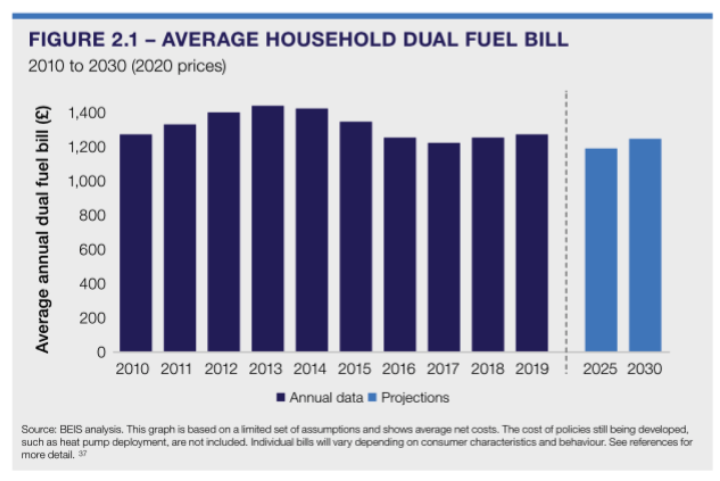Energy White Paper: time for delivery
The Government's White Paper gives us a welcome glimpse of the future
By Jonny Marshall
Share
Last updated:
A good White Paper delivers two things: an overall trajectory and a slew of strategies, plans and consultations.
Landing the first part requires sufficient political will to make tough calls and give sharp signals on how our energy system will look in decades to come, allowing the nitty-gritty of effective policy formulation to come in following weeks and months.
News on nuclear rightly led the morning news – there are few more contentious decisions in energy policy – but the common themes running through all 170 pages of the White Paper were of notable progression towards net zero.
Big Calls
The White Paper is not short of decisions, implicit and explicit.
Opting for a carbon trading scheme post-Brexit rather than a carbon tax has been a long time coming (and reflects well-grounded concerns over the ability to ministers to change taxes at the drop of a hat). This one will have big implications in the short term, with clarity needed on overall trajectories and free credit allocations as soon as possible to help prevent another Brexit cliff-edge.
There is also a clear backing for a more dynamic and responsive electricity grid, with acknowledgements that the system of the future will not look like that of the past. This has been long-seen as essential for getting back on track to net zero.
Regulation overhauls, more storage, more interconnection, using data more effectively and regulator reform sit among a litany of pledges to modernise our outdated power grid, allowing it to be based overwhelmingly on cheap wind and solar.
This feeds through into a vision of more informed and engaged consumers, making the most of clean and cheap renewable energy to run smart appliances, power heat pumps, and for smart charging of electric cars to become the norm.
New data strategies, moves to half-hourly pricing, ‘energy-as-a-service’ and a call for evidence on affordability and fairness will all be essential in delivering the net zero policies that actually impact on family lives, as well as preparing the nation for a widespread switch away from gas boilers ‘by the mid-2030s’.
One thing that will certainly help is BEIS modelling shows this vision can be achieved without bills increasing. It is one thing talking about more engaged households, another entirely trying to do so if energy costs are set to rise.

Steps towards low carbon industry – albeit many top-lines regurgitated from the Ten Point Plan – also give a vision of the future, with high-skilled, low-carbon jobs dotted around the country.
The effective delivery of low carbon clusters is essential, as is ensuring that hydrogen is used where it is most effective, and that long-overdue CCS projects are delivered.
Elsewhere, getting ahead of the curve on electric vehicle sales - making sure there is more than enough chargers and juice to flow through them - and on clean heat are also trends. Boosting network investment, changing Government communications (especially on heat), and policies to front-load EV sales are all vital in making this happen.
Net Zero Basin
One of the largest calls in the White Paper should see emissions from the UK's domestic oil and gas sector eradicated by mid-century.
Delivering on the promise of a ‘decisive and permanent shift away from our dependence on fossil fuels’ would not fit with continued hydrocarbon extraction from British soil.

There has been a long-standing incompatibility between plans to decarbonise the nation and those aiming to extract as much oil and gas from under the North Sea as possible.
There are few areas of domestic policy as ripe for ‘Bidenisation’ as those that involve moving away from oil and gas. Recent announcements on ending sales of petrol and diesel cars, as well as ending UKEF funding for overseas fossil fuel projects will have caught the eye of our Transatlantic friends; action to call time on North Sea oil and gas will do the same.
A net zero strategy for the Oil and Gas Authority, a North Sea Transition Deal, and continued backing for offshore wind and carbon capture have the potential for this shift to be quick, effective, and fair – quite the statement to make ahead of COP26.
Underselling?
Recent discussions around Governmental ambition on climate policy have unfortunately been bogged down in arguments over money, a to-and-fro that doesn’t help anyone, let alone those looking to raise pressure on the Government to cut carbon.
Thankfully, the Government has taken to providing updates on progress cutting carbon against the fourth and fifth carbon budgets; first in the Prime Minister’s Ten Point Plan, and now in the White Paper.
This is undoubtedly a good thing, but only if the numbers are right.
Today’s cumulative emissions saving has been pegged by BEIS at 230 MtCO2e by 2032, updated from the 180 MtCO2e identified in the Ten Point Plan.
Progress, certainly, but also almost definitely short-selling.
Recent analysis by Cambridge Econometrics found that actions in the Ten Point Plan alone would save more than 420 MTCO2e by 2032, enough, in fact, to close the gap on the (pre-net zero) fifth carbon budget.
Why the difference? The Government figures are based on the existence of targets alone, with few policies to deliver them. Concrete actions to jump start EV sales, clean heat installations or low carbon industries would allow BEIS to number-crunch these savings, would let the Government claim more credit for cutting carbon, and would give the wider sector the clarity needed to check progress towards net zero.
2021 awaits
The inevitable outcome of a White Paper is more documents on the Government’s to-do list.
The seemingly endless delays to plans for decarbonising transport, industry, homes and aviation, among others, are all expected in 2021 – the announcements in the White Paper only up the ante on what will be a very busy year in climate and energy policy.
The White Paper has mood music on the right track, now there is real potential for the detail to fall into place.
As such, the odds on the UK being back on track for net zero by the time COP26 rolls into town are thankfully shortening.
Share